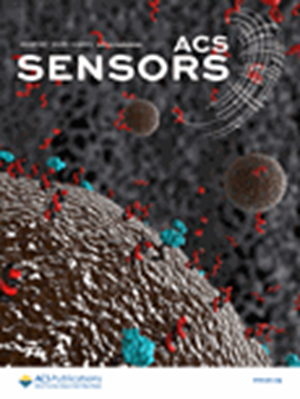基于双金纳米结构的可拉伸电化学发光传感器用于监测内皮细胞机械传导中的过氧化氢
IF 9.1
1区 化学
Q1 CHEMISTRY, ANALYTICAL
引用次数: 0
摘要
血流过程中的过氧化氢(H2O2)释放通常是由内皮细胞的循环拉伸和动态剪切应力引起的,对维持血管功能至关重要。柔性可拉伸电化学传感器在检索机械刺激引起的 H2O2 变化方面表现出很强的能力;然而,细胞分泌物,尤其是电活性成分的干扰,仍然是影响传感精度的一大问题。在此,我们合成了 L012 还原金纳米球,并将其装饰到聚二甲基硅氧烷薄膜支撑的金纳米管基底(Au NTs/PDMS)上,形成双金纳米结构修饰的网状界面,从而开发了一种可拉伸的电化学发光(ECL)传感器。鉴于 L012 与 H2O2 之间的特异性反应,制备的 Au-L012/Au NTs/PDMS 对 H2O2 的定量具有出色的选择性。通过培养人脐静脉内皮细胞(HUVEC),实现了对机械敏感的 HUVEC 在拉伸状态下瞬时释放 H2O2 的实时监测。这项工作成功地将ECL传感模型融入到原位细胞传感中,从而拓展了ECL方法在医疗保健和生物医学研究中的应用模式。本文章由计算机程序翻译,如有差异,请以英文原文为准。

Dual Gold Nanostructures-Based Stretchable Electrochemiluminescence Sensors for Hydrogen Peroxide Monitoring in Endothelial Mechanotransduction
Hydrogen peroxide (H2O2) release during blood flow is commonly provoked by the cyclic stretch and dynamic shear stress of endothelial cells and is of vital significance for maintaining vascular function. Flexible and stretchable electrochemical sensors show great capability in retrieving mechanical stimulation-induced H2O2 variation; however, cell secretions, especially electroactive constituents’ interferences, remain a big concern for sensing accuracy. Herein, we developed a stretchable electrochemiluminescence (ECL) sensor by synthesizing L012-reduced gold nanospheres and decorating them onto a polydimethylsiloxane film-supported gold nanotubes substrate (Au NTs/PDMS) to form dual gold nanostructure-modified meshwork interface. Given the specific reaction between L012 and H2O2, the as-prepared Au-L012/Au NTs/PDMS exhibited outstanding selectivity toward H2O2 quantification. Through culturing human umbilical vein endothelial cells (HUVECs), real-time monitoring of transient H2O2 release from mechanically sensitive HUVECs in stretching states was realized. This work successfully incorporated the ECL sensing model into in situ cellular sensing, therefore expanding the application mode of the ECL approach for health care and biomedical investigation.
求助全文
通过发布文献求助,成功后即可免费获取论文全文。
去求助
来源期刊

ACS Sensors
Chemical Engineering-Bioengineering
CiteScore
14.50
自引率
3.40%
发文量
372
期刊介绍:
ACS Sensors is a peer-reviewed research journal that focuses on the dissemination of new and original knowledge in the field of sensor science, particularly those that selectively sense chemical or biological species or processes. The journal covers a broad range of topics, including but not limited to biosensors, chemical sensors, gas sensors, intracellular sensors, single molecule sensors, cell chips, and microfluidic devices. It aims to publish articles that address conceptual advances in sensing technology applicable to various types of analytes or application papers that report on the use of existing sensing concepts in new ways or for new analytes.
 求助内容:
求助内容: 应助结果提醒方式:
应助结果提醒方式:


